Sony Mobile Communications Inc. was a multinational telecommunications company founded on October 1, 2001, as a joint venture between Sony Corporation and Ericsson. It was originally incorporated as Sony Ericsson Mobile Communications, and headquartered in London, England, until Sony acquired Ericsson's share in the venture on February 16, 2012. On April 1, 2021, Sony integrated its electronics businesses including Sony Mobile into one company called Sony Corporation.

UIQ is a discontinued software platform based upon Symbian OS, created by UIQ Technology AB. It is a graphical user interface layer that provides additional components to the core operating system, to enable the development of feature-rich mobile phones that are open to expanded capabilities through third-party applications.

The Sony Ericsson P900 is a Symbian OS v7.0 based smartphone from Sony Ericsson.
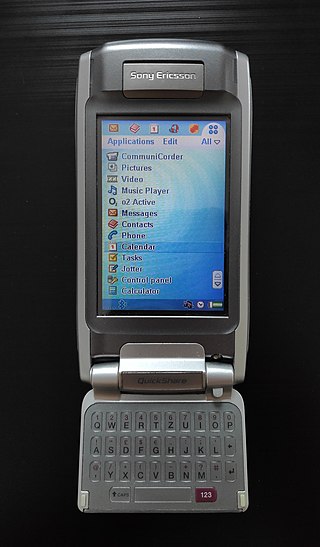
The Sony Ericsson P910 is a mobile phone by Sony Ericsson introduced in 2004 and the successor of the Sony Ericsson P900. The P910 has a full QWERTY keyboard on the back of the flip. The biggest change from the P900 to the P910 is that the P910 supports Memory Stick PRO Duo and the phone's internal memory has been upped from 16 MB to 64 MB. Although Memory Stick PRO Duo comes in larger capacities, the maximum supported by the P910i is 2 GB. It is powered by an ARM9 processor clocked at 156 MHz and runs the Symbian OS with the UIQ graphical user interface. The touchscreen displays 262,144 colours, as opposed to the P900's 65,536 (16-bit). It comes in three versions:

Siemens Mobile was a German mobile phone manufacturer and a division of Siemens AG. Siemens sold Siemens Mobile to the Taiwan-based BenQ in 2005, subsequently becoming BenQ-Siemens and succeeded by Gigaset. The last Siemens-branded mobile phones, the AL21, A31 and AF51, were released in November 2005.

Motorola A925 is a 3G mobile phone from Motorola using Symbian OS. Among the most notable features is its built-in A-GPS. The A925 was preceded by the featurewise essentially identical Motorola A920, and was succeeded by the Motorola A1000.
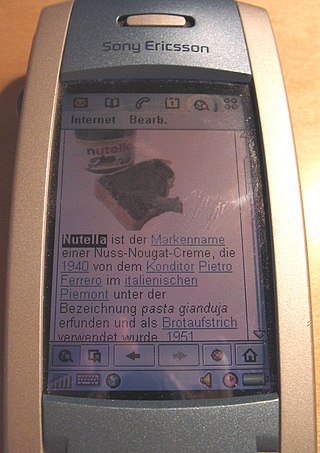
The Sony Ericsson P800 is a mobile phone introduced in 2002 based upon UIQ version 2.0 from Sony Ericsson. The P800 is considered the successor of the Ericsson R380, and initial design work was done within Ericsson, but it was produced after Sony & Ericsson merged their mobile phone businesses.
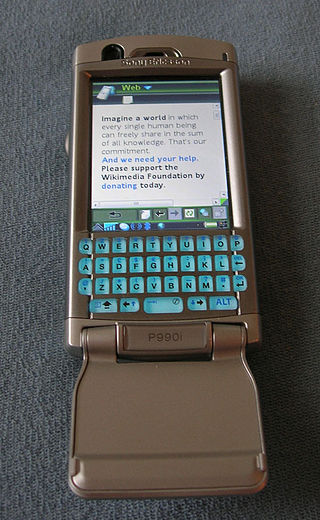
The Sony Ericsson P990 is a mobile phone and the successor of the Sony Ericsson P910. The phone uses the UIQ 3 software platform, which is based on Symbian OS 9.1. During development, the phone was codenamed Hermione, after the Harry Potter character of the same name. It was introduced on 11 October 2005, but had a long delayed market release only in August 2006.

The Sony Ericsson W900i is a 3G mobile phone manufactured by Sony Ericsson. The display of the device is a 240×320 pixel 262,000 color 2.1-inch TFT QVGA screen. It has a swivel form factor, which makes the W900 larger than many other phones when folded open. In addition to the 470 MB of internal flash memory, it also supports the Memory Stick PRO Duo as external memory. It has class 10, 32–48 kbit/s GPRS. The W900 can achieve data transfer rates of 384 kbit/s due to its 3G technology. It also includes Bluetooth, a 2-megapixel digital camera with auto-focus and the ability to take QVGA video at 30 frame/s supplemented by a second VGA camera used for video calling and self-portraits and most advertised of all, its ability to play MP3 audio files in Walkman mode for up to 30 hours and its ability to play long length MPEG-4 videos. When using the W900i as a phone, the standby time is up to 379 hours and talktime of up to 8 hours and 40 minutes. Its dimensions are 109 mm × 24 mm × 49 mm and its weight is 148 g (5.2 oz). It also has an internal NVIDIA GoForce 4800 graphics processor and was bundled with the HPM-80 headset.

The Sony Ericsson W950i is the third UIQ 3 smartphone based on Symbian OS v9.1. It was announced on February 13, 2006, a week after the announcement of the Sony Ericsson M600.

The Sony Ericsson K800i, and its variant, the Sony Ericsson K790, are mobile phone handsets manufactured by Sony Ericsson. Launched in July 2006, the phones are the successor to the Sony Ericsson K750i, and are the first to be tagged with the Cyber-shot branding. Both of the phones feature a 3.2-megapixel digital camera complete with a xenon flash, a protective lens cover, and a new "BestPic" bracketing feature. The new "BestPic" feature takes 9 full quality snapshots of a subject in quick succession, allowing the user to choose the best shots from them. On the entertainment front, the phones have a media player supporting MP3, AAC/AAC+/eAAC+ and WMA music files and 3GP/MPEG-4 video files. The phones also feature a RDS FM radio, and a Memory Stick Micro (M2) slot for expandable solid state memory. The K790/K800 models are also the first Sony Ericsson mobile phones to use ATI's Imageon 2192 graphics engine, which delivers a full 3D gaming graphics for Java and full support for its 3.2-megapixel camera. It is the phone used by James Bond in the 2006 Casino Royale film and trailers.

The Sony Ericsson K810i is a dual-mode UMTS phone with a 3.2 Megapixel camera with autofocus and 16x digital zoom. It has the full range of mobile entertainment and business features including video telephony, Memory Stick Micro removable storage, picture blogging, full HTML browser, RSS feed support, and music and video players. It is a later iteration of the Sony Ericsson K800i, and both phones have since been succeeded by the Sony Ericsson K850i.
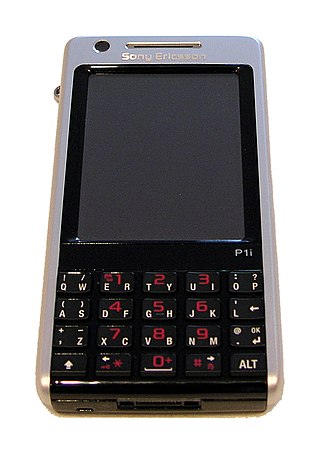
The Sony Ericsson P1 is a mobile phone and the successor of the P990. It was the last of the Sony Ericsson "P" Smartphone series, introduced in 2002 with the Sony Ericsson P800 and it integrates many of the hardware features of its predecessor the P990 in the form factor of the M600. It was announced on 8 May 2007. There is a Chinese version of P1 called P1c. Compare with P1/ P1i, P1c lacks of 3G, thereby using EDGE which is much slower but more available especially in the US and parts of Europe.

The Sony Ericsson K850i is a high-end mobile phone when released in October 2007. It was announced in June 2007 as the flagship product in Sony Ericsson's K ("Kamera") series, with a 5 megapixel CMOS camera sensor. The K850 was the first Sony Ericsson phone released outside of NTT DoCoMo to support microSD and microSDHC along with Sony's traditional M2. It also introduces the usage of three touch-sensitive softkeys right under the display and a new form of navigation button, omitting the classic joystick introduced with the Ericsson T68. The camera interface has been revamped to resemble the format of cybershot digital cameras. According to the manufacturer the UMTS talk time has been significantly increased to 3 hours 30 min over its predecessor, the K800 and K810.. It was Sony Ericsson's first 3.5G HSDPA supporting mobile phone, and was also the first 3G "global" mobile with supporting all major operating network frequency in the world including GSM 850, GSM 900, GSM 1800, GSM 1900, HSDPA, UMTS 850, UMTS 1900, UMTS 2100.

The Xperia X1 is a high-end smartphone from Sony Ericsson, and is the first in the manufacturer's Xperia series. The phone was designed and built by Taiwanese OEM HTC. The X1 was first presented at the 2008 Mobile World Congress.

The Sony Ericsson W960i is a 3G phone that Sony Ericsson announced in June 2007, as an upgrade to the W950.
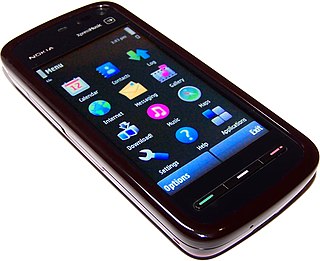
Nokia 5800 XpressMusic is a smartphone part of the XpressMusic line, announced by Nokia on 2 October 2008 in London and started shipping in November of that year. Code-named "Tube", it was the first touchscreen-equipped S60 device by Nokia – essentially it was the first device to run Symbian^1, also known as S60 5th Edition, the touch-specific S60-based platform created by the Symbian Foundation. The touchscreen features tactile feedback.

The Sony Ericsson Satio (U1) is a smartphone, announced by Sony Ericsson at the Mobile World Congress in Barcelona, Spain on 15 February 2009 as the Idou. It was released on 7 October 2009 in the UK in 3 colour schemes: Black, Silver and Bordeaux (Red).

The Sony Ericsson Xperia arc S is a high-end smartphone developed by Sony Ericsson running Google's operating system Android 2.3.4 (Gingerbread). It is an upgraded version of the Sony Xperia Arc. It is the last phone announced to carry the Sony Ericsson brand, although Sony Ericsson Xperia active was the last phone completed before Sony bought Ericsson's stake in the joint-venture.


















